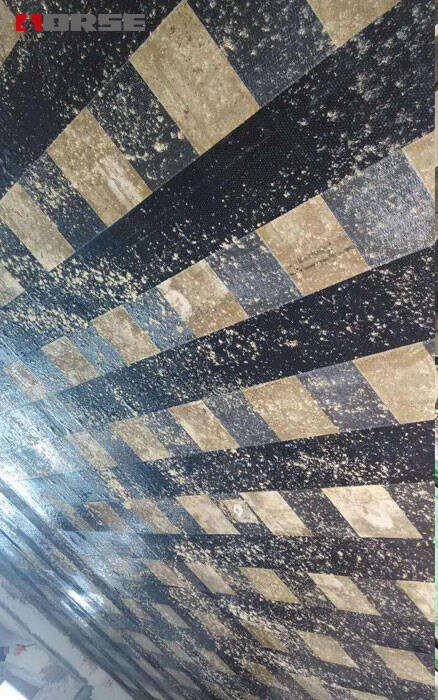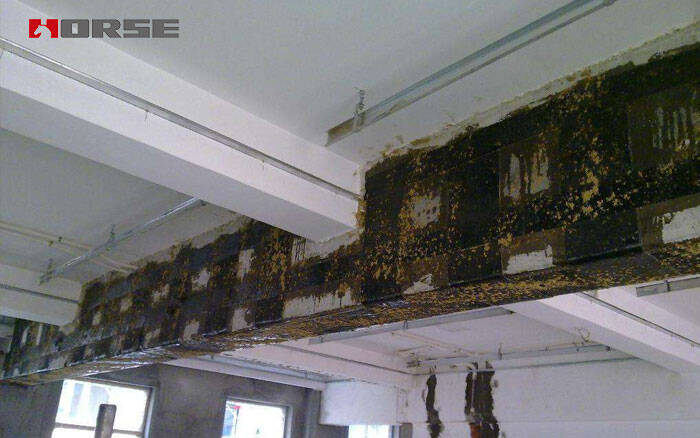Renforcement des poutres et des dalles
plaque renforcée en tissu de fibre de carbone
La technologie de renforcement en fibre de carbone est idéale pour renforcer et consolider les structures et composants en béton. À condition qu'il n'y ait pas d'augmentation de la taille de la section transversale et du poids propre de la poutre, la période de construction, la durabilité du matériau, la qualité de la construction et d'autres aspects de la technologie répondent aux exigences du propriétaire.

et la technologie de réparation est un nouveau type de technologie de renforcement structurel. Il utilise une liaison adhésive en résine pour coller le tissu en fibre de carbone sur la surface du béton afin d'atteindre l'objectif de renforcer la structure et les composants.
Causes de la capacité portante insuffisante des poutres et des dalles et objectifs du renforcement structurel
(1) La capacité portante des éléments de flexion tels que les poutres et les dalles est insuffisante parce que la résistance du béton ne peut pas répondre aux exigences de conception pendant la construction ou en raison d'un renforcement insuffisant et d'une non-conformité.
(2) La principale raison de la capacité portante insuffisante des éléments de flexion tels que les poutres et les dalles dans la conception est que l'esquisse de conception ne correspond pas à la contrainte réelle des poutres et des dalles, ou que la charge est omise ou sous-estimée.
(3) Une surcharge importante pendant l'utilisation entraînera également une capacité portante insuffisante de la poutre et de la dalle.
(4) Autres raisons : un tassement irrégulier de la fondation provoque une contrainte supplémentaire dans la poutre ; des composants immatures sont utilisés ; et l’influence des formes des composants.
Le but du renforcement structurel
(1) améliorer la résistance de la structure et du composant
(2) améliorer la stabilité de la structure et du composant.
(3) améliorer la rigidité de la structure et du composant.
(4) améliorer la durabilité des structures et des composants.

Comportement mécanique des structures en béton armé
Le comportement mécanique d’une structure renforcée diffère de celui d’une structure normale sans armature. Premièrement, la structure renforcée appartient à la structure secondaire. Avant le renforcement, la structure d'origine a été soumise à une charge (c'est-à-dire la première charge) et la structure d'origine présente une certaine déformation par compression (ou flexion). Dans le même temps, le béton d'origine de la structure a pratiquement terminé sa déformation par retrait. Le renforcement est généralement effectué sans déchargement. Lorsque la nouvelle pièce est chargée, c'est-à-dire sous la deuxième charge, la contrainte et la déformation de la nouvelle pièce sont inférieures à la contrainte et à la déformation de la structure d'origine. Par conséquent, la nouvelle structure et l'ancienne structure ne peuvent pas atteindre la tension de crête en même temps et, lorsqu'elle est endommagée, la nouvelle pièce peut ne pas atteindre son état ultime. Deuxièmement, les parties nouvelles et anciennes de la structure renforcée présentent le problème de la performance intégrale, et la clé de la performance intégrale est de savoir si la force de cisaillement peut être efficacement transmise à partir de la surface du joint. En raison des caractéristiques mécaniques mentionnées ci-dessus de la structure renforcée, sa méthode de calcul, son traitement structurel et ses exigences de construction sont différents de ceux de la structure en béton ordinaire.
Renforcé avec du tissu en fibre de carbone
(1) Convient pour le renforcement et la réparation de divers types de structures et de pièces, telles que poutres, dalles, colonnes, fermes de toit, supports, ponts, cylindres, coques et autres structures.
(2) la classe de résistance du béton de base n'est pas inférieure à C15.
La technologie de renforcement en tissu de fibre de carbone est idéale pour renforcer et consolider les structures et composants en béton. À condition qu'il n'y ait pas d'augmentation de la taille de la section transversale et du poids propre de la poutre, la période de construction, la durabilité du matériau, la qualité de la construction et d'autres aspects de la technologie répondent aux exigences du propriétaire. Ses avantages économiques et sociaux globaux sont bons et ont une grande valeur de vulgarisation et de pratique.